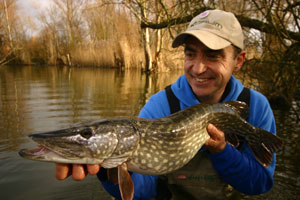Sinister-looking and foreboding with evil, staring eyes and a flattened snout filled with rows of needle sharp teeth – there is absolutely no mistaking the pike!
Top of the freshwater food chain, fewer species have generated as many myths and legends as ‘old Esox’.
However, reality is far removed from folklore and in truth pike are a fragile species, which are beneficial to our fisheries, deserving of respect and very much in need of the gentle touch.
Over the years I’ve fished for them on all sorts of water from tiny Fenland drains and rivers to vast, windswept reservoirs and everything inbetween. I was undecided about just where to fish this session until I received a call from an old friend telling me he had been watching the pike in his local lake grouping up to herd shoals of fish into a small bay. Would I fancy a crack at them? You had better believe it!
Although the pike in question were not monsters it sounded like it could be an action-packed day and just what I needed to blow away a few cobwebs following a bout of the ’flu which appears to have knocked everyone for six this winter. My son, Liam, was champing at the bit too – he’s coming along nicely as an angler but had yet to tangle with a pike; this might be just the chance!
The big day arrives. Getting to grips with pike calls for an early start as feeding spells are frequently at first light. I’m keen to have a bait in the water while its still dark. In addition to setting the 5am alarm call I also check my bedside weather station and log on to the online forecast. All fishing is governed by the elements to some extent but for pike it is especially important as their behaviour is greatly influenced by atmospheric pressure.
During periods of low pressure pike are largely inactive and tend to be caught primarily on deadbaits. On high-pressure days they are on the move and frequently favour livebaits.
After a long period of low pressure the barometer is now rising steadily; it’s not foolproof and some waters react better than others, but it’s an observation which rarely lets me down.
I’ve sorted a few deadbaits as a back-up, but it looks like young Liam is going to be tiddler snatching for me!
On arrival I’m given a bit of a head start with a tip-off that pike are smashing into the prey shoals in one of the bays.
Finding pike on any water relies on finding the fish they are feeding upon and to help you along I’ve listed the clues I would normally look for when trying to locate pike in this piece.
Today I’ve got a very sexy-looking, reed-fringed bay stretching away to my right. At the mouth there is a small island with a run of snags on the far bank and a tree right in the margins just a rod’s length out where the depth starts to drop away. That has got to be a prime spot and as I try to get my bearings in the half-light a fish swirls at my feet – time to get set up!
I’m going to upset a few people here, but most of the so-called pike rods you find in the shops are just too heavy!
Rods of 3lb test and above are fine if you are looking to punch big baits out to range on inland oceans, but for general live- and deadbaiting on rivers and drains, and close- to medium-range fishing on pits and lakes, they are just OTT.
For today’s outing, and indeed most of my pike fishing, I’ve got two12ft Fox Predator XS in 2.5lb test. These comfortably deal with baits to 4oz yet still allow me to enjoy the fight. If I really need to whack out to longer range there are 2.75lb and 3lb test of the same range back in the car.
 |
| Ian loves these ‘rattlers’. |
Reels need to have a large, high-capacity spool for some specialised aspects of pike fishing such as drift float fishing, so I’ve got my big Daiwa Emcasts fitted. But any model which will comfortably hold 200m of 15lb line will do the job.
Line quality and strength is one aspect which cannot be skimped on, though, with a reliable 15lb mono the absolute minimum. For long-range work I favour the lack of stretch a high breaking strain braid provides, but for close-in work I’m happy with the 15lb Big Game I’m spooled up with today.
Rigs for pike fishing are many and varied, but today there are plenty of pike striking, so I’m going to keep it simple and present a couple of free-roaming livebaits beneath a Fox Livebait Slider, one working the near margin, the other searching the far bank and the entrance to the bay.
I’ve got a couple of rubber stops up the line to prevent the float from slipping and I’m going to present the baits well up in the water, allowing the pike to hit them from below – perfect tactics for this situation.
Make Your Own Pike Trace
There are as many different ways to make pike traces as there are types of wire. Ian is a fan of twisted rather than crimped traces and finds them far more simple and bombproof!
At the sharp end he has a 45cm trace formed from Drennan seven-strand wire in 28lb breaking strain. There are many different grades and types of wire in the shops and he’ll sometimes look for something lighter or more supple if he’s zander fishing or chasing finicky pike. But for day-to-day use the seven-strand 28lb has never let him down. Armed with a pair of size 8 semi-barbed carbon trebles it’s tough as old boots.
He admits though that his method of creating twisted traces is a little off-the-wall and he thinks it’s possibly unique in the pike fishing world! But they are very quick to make, neat, simple and very strong!
 |
| 1 To get a tight and even twist that beds beautifully and will never slip, Ian uses a cigarette lighter to heat the end 3cm of the trace wire until it glows red-hot. |
|
 |
| 2 He then slides the bottom treble hook on, doubles over the heated section of wire and, holding the loose end tight to the main run of wire, twists rapidly with a hooked ET ‘Twiddlin’ Stick. |
|
 |
| 3 The result, due to the heat briefly making the wire more supple, is a perfectly tightly wound finish. |
|
 |
| 4 To tidy up he sheaths the bottom treble with a short length of silicone tube before positioning the upper hook in relation to the size of bait he’s using. |
|
 |
| 5 Ian’s using small roach in the 10-12 cm range, so sets the top hook 6cm above the lower, allowing him to nick one in the pectoral fin and the other in the dorsal. |
|
 |
| 6 To lock the upper double hook in place he uses a single turn of the wire trace around the length of the shank. |
|
 |
| 7 Next Ian wraps six turns tightly around the shank and once back up through the eye to lock the hook in position. |
|
 |
| 8 To hold the wrapped trace in place a Fox treble sheath over the top gives a nice, neat finish. |
|
 |
| 9 Use the lighter at the other end of the wire, twist your swivel on and sheath it with a silicone tube to complete the trace. |
|
 |
|
10 The finished trace, plus rattle, is perfect for fishing the small livebaits he’s using for today’s session.
|
|
With both baits out and signs of pike moving I’m confident of early action, but it is a surprisingly slow start, and despite flicking my baits towards signs of pike movement the first hour is fishless and I’m getting increasingly frustrated!
In the end I decide to stop chasing the fish and wait for them to come to me – and it works! The margin bait is taken with an almost audible ‘plop’ and the line is peeling off the spool steadily – here we go!
 |
| This chunky pike goes to about 8lb – there’s a hungry pack of these in Ian’s swim. |
How long to wait before setting the hooks has been written about more than almost any aspect of pike fishing. Mr Crabtree used to smoke a pipe before taking any action. Many books advised waiting for a second run, but the truth is that every situation is different.
Some days a pike will wolf a bait down on the spot. On others it will steam off with the bait in its mouth without taking it properly. And on yet others it will toy with a bait grabbing and releasing without ever taking it properly.
The bottom line is that the longer you delay the greater the risk of your bait being swallowed and ending up with a deep-hooked fish, so always act sooner rather than later. After a few seconds and as soon as the line is moving steadily off the reel is usually about right.
Rather than actually strike, which can pull the hooks out of the mouth, I simply wind down hard and start playing the fish; it results in far fewer lost fish.
Today it’s clear the pike are running without taking the bait properly and I feel the predator briefly before the hooks pull! A delayed ‘strike’ on a subsequent take brings a similar result, and it’s only when I get a third chance that I finally get my timing sussed and the first fish of the day is on the bank. What a relief! Now I’ve got the measure of the way they are behaving I’ll be unlucky to drop another!
Running off quickly without swallowing the bait is typical pack behaviour, so the plus side of these takes is that there are likely to be lots of fish in the area, and so it proves with runs coming regularly now, especially on the inside line.
Pike care and unhooking is a massive subject, and if you are new to this branch of the sport and trying to earn that very first Korum pike badge I would strongly recommend you go with a friend who knows the ropes for your first couple of trips.
I’ve got my big Korum mat with long-handled forceps, pliers and a set of wire cutters to hand, and Liam is all eyes as I show him the correct way to hold the fish so they open their mouth and are unable to close it. All of today’s fish are only just hooked though and I don’t need forceps for many of them.
 |
| The pike are on a real feeding frenzy – this one has a mouth full of roach fry! |
The unhooking process has certainly shown me what these pike are feasting on – some of them are choked to the gills with tiny roach fry! To mimic the natural situation as much as possible I’m going to select the very smallest bait fish – it can really make a difference.
With a few nice fish finally under my belt after an unpromising start I’m not too concerned when the action slows late in the morning. Pike on many waters exhibit a very marked early morning feeding spell with the action slowly petering out towards midday. There’s often a secondary feeding spell at dusk or even just into darkness, but I’m content to pack up and share a cuppa in the fishery lodge with a few old friends.
Liam, however, has other ideas. He’d been scouting up on the shallows right at the back of the bay amongst the Norfolk Reed, and although there’s literally only a couple of feet of water he’s clocked signs of fry scattering and pike striking. My swim dried up not because the pike had switched off but because they had moved past me and herded the fry into the furthermost corner of the pit!
There isn’t an official swim as such, but Liam works his way between the reeds, moves the float stops down to just 30cm above the hooks and deftly flicks a roach across to the far bank. It’s a cracking cast and within a few minutes it gets the result it deserves. I talk Liam through the hook-setting procedure and grin like the proud dad I am when his first pike hits the onion sack!
From there on he takes over and with some seven or eight good fish in little over an hour he ends up giving me a lesson in winter gravel pit pike fishing!
 |
Top Tip
The days when the only pike float you could buy was a ‘Gazette’ bung are long gone! These days you should always select your pike floats according to the baits you are fishing. Streamlined, cigar-shaped models are great for low-resistance deadbait work. Opt for dumpy, top-heavy shapes to support livebaits. |
|
 |
tcf Advanced Tip
Leave your rod pods at home when out on a pike session! To reduce resistance and minimise dropped runs from finicky or pressured fish use individual bank sticks instead and point your rods directly at your baits. |
|
 |
Top Top
Always ensure you are fully prepared to unhook a pike safely. Ian has a big Korum unhooking mat with long-handled forceps, pliers and a set of wire cutters all close to hand so he can quickly remove the trace and return the fish without too much stress. |
|
 |
| On one trace Ian adds a red plastic Fox Bait Flag. This acts as an additional sight target for feeding pike and the flash of red can really make a difference for what is primarily a sight-feeding species. |
|
Ian’s Guide To Pike Location
1. Direct signs of fish
Even in the winter fry and small fish can be very active. Look for dimpling on the surface at first and last light during calm weather. The scattering of fry in response to a strike is also a dead giveaway.
2. Indirect signs of fish
Don’t worry if you can’t see any prey fish – there are other signs of their presence and one of the most reliable is to watch out for birds that feed on fish. Grebes regularly diving over an area are always a great indication and even if he’d fished this session blind, the pair of kingfishers working the bay all day would have given Ian a pointer. When it comes to pike location, even cormorants have their uses!
3. Wind direction
A good blow moves food items across a water and the fish that feed on it are quick to follow, especially if it’s from the south or west. You can be sure the predators will be tracking any fish movements, so keep wrapped up and fish with that wind in your face. Think twice in northerly or easterly blows though – they can be very cold and the prey fish may just stay on the back of them!
 |
| Ian fixes a Fox Stubby Sinker above the swivel to match the loading of his float. |
|
 |
| To set the required depth, Ian has two float stops placed two feet above his float. |
|
4. Snags and shelter
Pike are ambush predators built for short bursts of speed rather than sustained swimming so will always seek out areas of cover to strike from. Fry and other prey fish look for a roof over their heads too so I’m always keen to cover any such areas, however small, with a bait.
5. Marginal drop-offs
With eyes set high on their head, pike are built to strike from below and many of my favourite swims are at the bottom of marginal drop-offs where the pike patrol look to sight their prey silhouetted against the sky above. Whatever water he’s on, Ian will always put one bait in the edge where the water begins to deepen off.
6. Seasonal preferences
Time of year also plays a major part in location. Now, at the back end of the season, pike will be beginning to think about spawning in many fisheries so check out any shallow, snaggy bays for signs of activity.


























